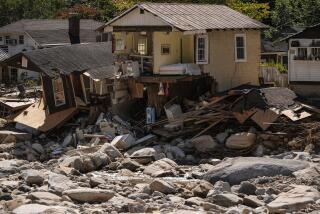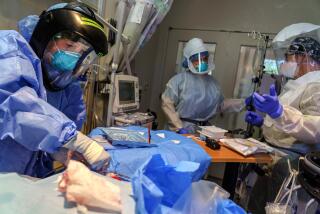Opinion: Hurricane Katrina and the tyranny of magical thinking
Floodwater was everywhere — muddy-brown and streaked in pockets by an oily film. It covered the streets. It covered the lawns. It covered plazas and parking lots. And it lapped softly up against my porch, threatening to crest the lip and continue on through my front door.
I’d never seen anything like it in my life — and all I could do in response was crack open a beer, smile and take the whole scene in.
In front of me, a group of women in bikinis, empty red cups in hand, ran barefoot through the slop on their way to find a keg of beer. It took less than a minute for them to come across a pack of shirtless men, covered in mud, who were more than happy to share their alcoholic bounty.
Nearby, a raised truck cruised past, towing a floating inner tube in its wake. Strangers hopped in the tube and went for a ride. Music boomed from all directions.
If I wasn’t already smitten with New Orleans, I was now. This city was magical.
As you may have guessed, I’m not talking about the aftermath of Hurricane Katrina. The year was 1998, and the city of New Orleans had just endured an assault from Hurricane Georges. Rains overwhelmed the city’s ancient pumping system, but its levees held. A near catastrophe had turned into bacchanalia.
I was a freshman at Tulane University — mere weeks removed from an orderly, natural disaster-free life in my home city of Boston — too dumb and naïve to know I should have been terrified. The idea that an entire American city could be allowed to wallow under the threat of imminent destruction hadn’t previously occurred to me.
My local friends knew better, but they didn’t seem to let the thought bother them. The night before Georges made landfall in the U.S., nearly everyone I spoke with recited some version of what, for them, had been a lifelong trope.
“If a storm actually hits us, the levees won’t hold. We’ll all be underwater. But the storm won’t hit. They never do.”
Sure enough, just like countless storms before it, Georges veered to the east at the zero hour, saving the worst of its wrath for those foolish enough to live in Mississippi, Alabama and Florida. New Orleans, magical place that it was, was safe.
It was a big, charming lie, another part of New Orleans’ mystical aura — and I was more than happy to buy in.
Of course New Orleans wasn’t safe. That’s obvious now, 10 years after Hurricane Katrina nearly flushed the city into the bayou.
But it was obvious then too, for anyone who cared enough to look.
During my four years in New Orleans, both the Times-Picayune and the Houston Chronicle ran blockbuster exposés documenting the weaknesses of New Orleans’ flood-protection system. Both said a disaster of epic proportions was only a matter of time. Both lamented federal and state inaction to prevent what was known to be one of the likeliest and potentially deadliest disasters to hit the United States — an earthquake in San Francisco or a terrorist attack in New York being the others.
“[W]e’ve been lulled to sleep,” Louisiana State University’s hurricane center director Marc Levitan warned in the Chronicle.
Those calls to action weren’t enough. The same magical coping mechanism that enabled city residents to live without fear seemed to empower the rest of the country to ignore the certain danger one of its cities faced. It was easier (and cheaper) to believe that New Orleans was divinely touched than it was to fix its aging levees or its eroding wetland storm buffers.
Ten years after Katrina, it’s imperative to remember most of the devastation New Orleans endured was no “natural” disaster: It was a preventable tragedy.
But divine providence wasn’t New Orleans’ only exercise in self-deception. And it wasn’t the only tragedy aided by the tyranny of magical thinking.
Why question anything?
I remember the first night I spent in the French Quarter like it was yesterday: underage, walking down Bourbon Street with a particularly boozy hurricane cocktail in hand, every saccharine sip endowing me with a taste of freedom I had never known.
After hours of wandering in and out of bars, my friends and I, music ringing in our ears, eventually stopped to watch a group of 8-year-old African American boys with bottle caps stuck to the bottoms of their shoes, tap-dancing for change (a common sight in those days, less so now). We never questioned what these kids were doing out unsupervised in the wee hours of the morning. We never bothered to consider the city’s failing schools and crushing poverty.
This city was magic after all. Why question anything when everything around you was so damn romantic? I threw a dollar in the boys’ hat, mightily proud of myself that I may have played a small part in the birth of the next Louis Armstrong.
“It is better to live [in New Orleans] in sackcloth and ashes than to own the whole state of Ohio,” as the saying goes.
Another lie, of course, as the city’s violence should have told any thinking person. New Orleans didn’t earn the title “Murder Capital of the United States” 12 times since 1985 by serving as the model of benign poverty.
Years later, I look back in disgust that I allowed myself to fall for the toxic romanticization of the lives of the city’s poorest residents. In fairness, I certainly wasn’t the only one. The humor and grace with which poor African Americans endured their lot was all part of the tourist package. Only in New Orleans could a homeless man trying to sucker you out of five bucks with the phrase “Betcha I can tell ya where ya got dem shoes!” become a tourist attraction.
The name of the city’s most famous sandwich, the po’ boy, almost says it all.
Like its shoddy levees, New Orleans’ social inequality was born of conscious neglect, and generations of primarily African American youth were sacrificed to the poisonous notion that their charming desperation was as an invaluable ingredient as jazz to the city’s cultural stew.
Charles Bukowski probably said it best:
“there was something about
that city, though
it didn’t let me feel guilty
that I had no feeling for the
things so many others
needed.
it let me alone.”
A city rebuilt, but how well?
If there is one gift Katrina gave New Orleans, it was to snap the city’s hypnotic spell and lay its precarious environmental stasis and racial and economic inequality bare for the world to see.
That unveiling didn’t seem like a gift at first. With the city’s magical defenses lying in waste, how many “Should New Orleans be rebuilt?” stories did we see from the smug Northeast media, delivering kick after kick to the liver when the city was down?
(Coverage from the national media leading up to Katrina’s anniversary, I should note, has been far more contrite than it was in the aftermath of the storm — a circumspection, I hazard to guess, born in the wake of Super Storm Sandy.)
Eventually, reason and humanity won out, and it was decided that, yes, one of America’s great cities shouldn’t be abandoned to the bayous. Its immediate existence secured, the city once again was flooded, this time with raw examinations of class, race and inequality — and with earnest newcomers from around the country, eager to keep the dialogue alive.
Ten years after Katrina, New Orleans’ levee system has been rebuilt and reinvented — as has its failing school system. It’s safe to say the city is undergoing an economic renaissance. Hollywood has arrived in force, with massive production budgets in tow, and a new generation of young outsiders has stormed the remaining stock of shotgun houses that Katrina failed to destroy.
By most accounts, many of these newcomers are far more engaged than I ever was when I first showed up in New Orleans nearly two decades ago.
That said, after 10 years of honest soul-searching, it’s hard not to suspect a new layer of magical varnish is beginning to gloss over New Orleans’ enduring frailties.
Despite all its storm-protection improvements, New Orleans still isn’t safe. Its new armaments are stronger than they were in the run-up to Katrina, but they are built to withstand only a 1-in-100-year storm (Katrina was a 1 in 150). Without massive coastal restoration, that level of protection likely will erode even further as Louisiana’s coastal wetlands dissolve into the Gulf of Mexico. Violent crime is up, and despite earnest attempts at reform, the city’s crushing poverty has been pushed further to the margins by a wave of gentrification.
After a decade of struggling to rebuild, does the city have enough fight left to push for a just transformation? Or will it give way to the temptations of its newfound prosperity? Is America willing to spend the $50 billion it will take to restore south Louisiana’s wetlands and further arm New Orleans’ flood-protection infrastructure? Or will we once again play dumb, sip our hurricanes come Mardi Gras time and act shocked when another Katrina tears New Orleans asunder?
Protecting against the next Katrina will be a challenge. Protecting against the magical thinking that left the city naked and exposed to a deadly hurricane strike and allowed generations of its citizens to stagnate in poverty — that’s the real monumental task ahead.
Follow the Opinion section on Twitter @latimesopinion and Facebook
More to Read
A cure for the common opinion
Get thought-provoking perspectives with our weekly newsletter.
You may occasionally receive promotional content from the Los Angeles Times.











